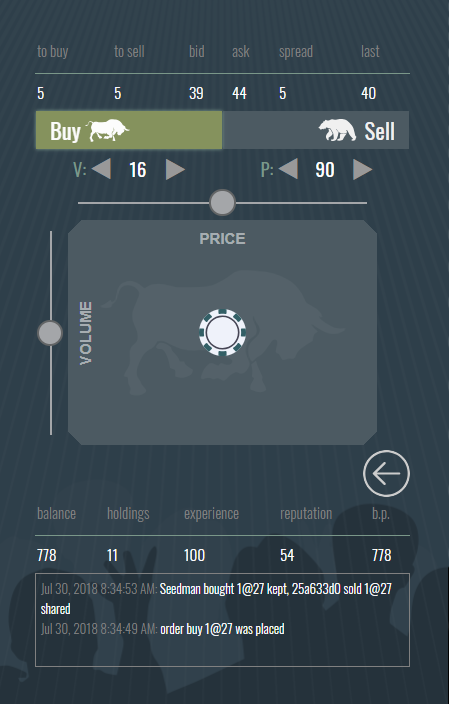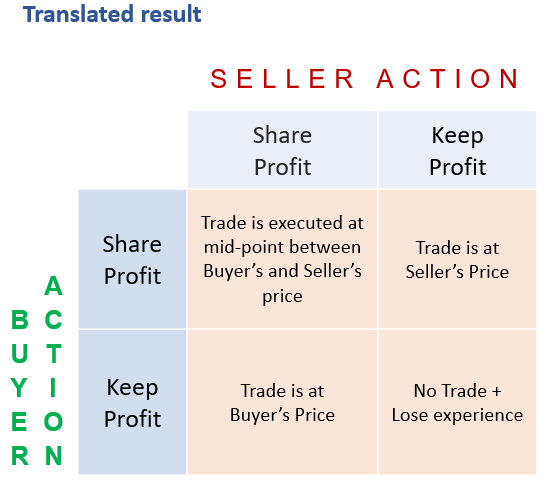There are three ways to trade in Tradefor:
-
- Using a trade ticket (“Ticket”)
- On the trading floor with puppet traders (“Floor”)
- In a peer-to-peer environment (“LIVE”).
Here is a quick overview of each method of trading:
The Trade Ticket
The Trade Ticket is available by clicking on “Ticket” in the header. It has a simple slider for indicating the quantity of the units you want to trade. All orders are market orders. This means that the volume and price of the units transacted will be determined by market availability. You will buy on the ask price and sell on the bid price.

The Trading Floor
The Trading Floor is a 24/7 market of avatar traders who reflect the orders posted within the LIVE market. The floor is a good place to transact if you want to keep it simple. Start by selecting whether you want to buy or sell. If you see on offer you like, click on the trader for your trading options. For example, you want to buy, your options will be: “buy one” or “buy ’em all”.
If they are no orders to show, the traders will be idle. Also, If you are too slow in making a decision, the trade may be snapped up by another player.

Tradefor LIVE
Tradefor LIVE is a peer-to-peer trading system consisting of two views:
Order View (below)

Market View (below)

You can swipe left or right to alternate views.
The trade view is where you set up your orders. You start by selecting whether you want to buy, or sell. Once you select your directional sentiment, a coin will be displayed in a set-up box. Move this coin by holding and dragging it within the box to set up your order parameters. Moving the coin up and down sets volume. Back and forth sets price. To improve your chances of getting the best possible price, you may want to set a price that is close to the bid or ask. Once you set your order, your view will change to the market view.
The market view shows all the buyers and all the sellers in the market. This is where you find traders with whom you want to negotiate a trade.
One of three things can happen in the LIVE market:
-
- Someone will select you as a potential counterparty to a trade.
- You will select someone as a potential counterparty to a trade.
- Nothing will happen. But your order will be posted until you cancel it.
If you are selected by someone else as a potential counter-party, you will have to go through the quick-fire negotiation, or alternatively, you can elect not to trade with the other person. You can block the person for the whole market session (swipe up) or you can decline to negotiate one time (swipe left). Check the experience and the reputation metrics for the trader before you decide what to do.
A trade pairing occurs when both players are willing to make a trade. Note that the lowest volume between the two counter-parties will always be the volume of units traded. The price, however, will be negotiated using a simple “prisoner’s dilemma” selection process. Each party in the trade pairing will be served two options the results of which are revealed to each trader, simultaneously, after each party makes a selection.
The selection choices are:
-
- Share profit
- Keep profit
When both parties make a selection (without knowing each other’s selection) the trade price is resolved using this simple matrix :

If both parties “share” the trade is executed at the midpoint between each parties price. If the buyer “keeps” and the seller “shares”, the trade is executed at the buy’s price. If the seller “keeps” and the buyer “shares”, the trade is executed at the seller’s price. If both parties “keep”, there is no trade.
One more thing: Anytime you “keep”, you will lose two reputation points. Every time you “share” it will increase by one point. Everyone starts with a reputation of 50. If your reputation drops below 40, you cannot trade with market makers. So manage your reputation — as well as the reputation of others.
So there you have it. It’s hard to make a mistake because the stakes are low. Remember every time you “keep” your reputation will be reduced by two points. Every time you share, it will be increased by one point. Your reputation is viewable by all traders.
Now go for it.

